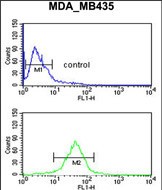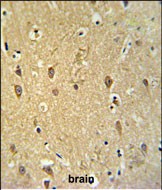


| WB | 1/1000 | Human,Mouse,Rat |
| IF | 咨询技术 | Human,Mouse,Rat |
| IHC | 1/100-1/500 | Human,Mouse,Rat |
| ICC | 技术咨询 | Human,Mouse,Rat |
| FCM | 1/10-1/50 | Human,Mouse,Rat |
| Elisa | 咨询技术 | Human,Mouse,Rat |
| Aliases | Uracil nucleotide/cysteinyl leukotriene receptor, UDP/CysLT receptor, G-protein coupled receptor 17, P2Y-like receptor, R12, GPR17 |
| Entrez GeneID | 2840 |
| WB Predicted band size | 41.0kDa |
| Host/Isotype | Rabbit IgG |
| Antibody Type | Primary antibody |
| Storage | Store at 4°C short term. Aliquot and store at -20°C long term. Avoid freeze/thaw cycles. |
| Species Reactivity | Human |
| Immunogen | This GPR17 antibody is generated from rabbits immunized with a KLH conjugated synthetic peptide between 230-258 amino acids from the Central region of human GPR17. |
| Formulation | Purified antibody in PBS with 0.05% sodium azide. |
+ +
以下是关于GPR17抗体的3篇参考文献概览:
---
1. **文献名称**:*"GPR17 Expression in Gray Matter Lesions of Multiple Sclerosis Brains"*
**作者**:Fumagalli, M. et al.
**摘要**:本研究利用特异性GPR17抗体,通过免疫组化技术分析多发性硬化症患者脑组织中GPR17的表达。结果显示,GPR17在病变区域的少突胶质细胞前体细胞中显著上调,提示其在髓鞘修复过程中可能发挥关键作用。
2. **文献名称**:*"Characterization of a Novel Anti-GPR17 Antibody for Targeting Myelin Repair Pathways"*
**作者**:Lecca, D. et al.
**摘要**:文章报道了一种新型GPR17抗体的开发与验证,通过Western blot和流式细胞术证明其高特异性。该抗体成功用于检测脑损伤模型中GPR17的动态表达变化,为研究神经再生机制提供了工具。
3. **文献名称**:*"Dual Role of GPR17 in Cerebral Ischemia: Insights from Antibody-Mediated Receptor Modulation"*
**作者**:Ceruti, S. et al.
**摘要**:研究采用GPR17中和抗体探究其在脑缺血模型中的双重功能。实验表明,GPR17在早期促进炎症反应,晚期则参与组织修复,抗体干预显著影响病理进程,提示其作为治疗靶点的潜力。
---
以上文献均聚焦于GPR17抗体的开发、验证或应用,涉及神经疾病机制及治疗研究。如需具体DOI或年份信息,可进一步补充检索。
**Background of GPR17 Antibodies**
GPR17 is a class A G protein-coupled receptor (GPCR) implicated in myelination, neuroinflammation, and tissue repair. Initially orphan, it was later found to respond to purinergic (e.g., UDP-glucose) and cysteinyl-leukotriene ligands, linking it to dual signaling pathways. GPR17 is highly expressed in oligodendrocytes, astrocytes, and specific neuronal populations, with roles in CNS development, injury response, and diseases like multiple sclerosis, stroke, and neurodegenerative disorders.
GPR17 antibodies are critical tools for studying its expression, localization, and function. They enable detection via techniques such as Western blotting, immunohistochemistry, and flow cytometry. Most antibodies target extracellular domains (e.g., N-terminus) or intracellular loops, with species-specific variants available for human, mouse, and rat models. Commercial antibodies are widely offered by suppliers like Abcam, Sigma-Aldrich, and Santa Cruz Biotechnology.
Challenges include low endogenous receptor levels and potential cross-reactivity with structurally similar GPCRs (e.g., P2Y receptors). Validation using knockout models or overexpression systems is essential. Recent studies highlight GPR17 as a therapeutic target, driving demand for high-affinity antibodies to evaluate drug candidates or biomarker potential in neurological and metabolic diseases. Ongoing research aims to clarify its dual ligand activation mechanism and tissue-specific roles.
×